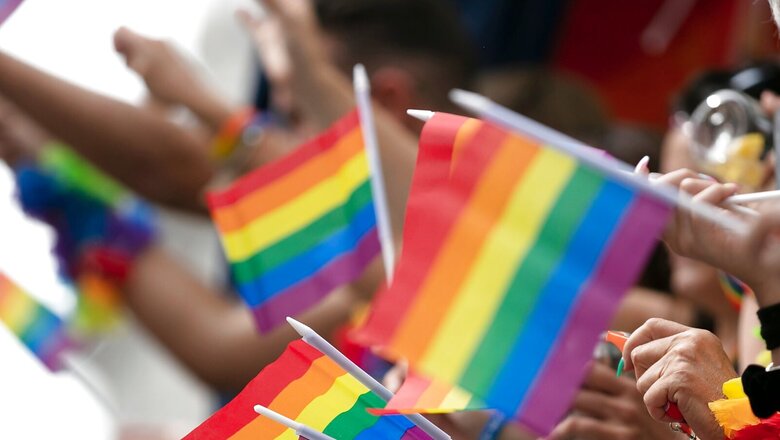
views
Sex may permeate our popular culture, but conversations about it are still associated with stigma and shame in Indian households. As a result, most individuals dealing with sexual health issues or trying to find information about sex often resort to unverified online sources or follow the unscientific advice of their friends.
To address the widespread misinformation about sex, News18.com is running this weekly sex column, titled ‘Let’s Talk Sex’. We hope to initiate conversations about sex through this column and address sexual health issues with scientific insight and nuance.
The column is being written by Sexologist Prof (Dr) Saransh Jain. In today’s column, Dr. Saransh Jain will discuss about LGBTQ+ Community and how it is related to different types of sexuality.
Lots of people have feelings for people of the same sex as them, being attracted to someone of the same sex is common, normal and makes you who you are. Some may be sure about how they feel, and others may take more time to be sure of their sexual orientation. Everyone is different and there is no right or wrong age to realise you are lesbian, gay or bisexual. Sexual orientation does not need to be fixed forever — for some people it will be, and for others, it will be fluid and it might change over time.
In recent years, it has become common to use the string of letters “LGBTQ+” to be inclusive of all individuals and communities who identify as lesbian, gay, bisexual or transgender. The early initiatives for people who were gay focused mostly on men. Therefore, in an attempt to draw attention to issues specific to gay women, “lesbian” is often listed first.
What Does Each Letter Mean?
Below are the few basic terms and concepts of LGBTQ+. These are just some of the many terms that are used to define sexual orientation, as well as gender identity and expressions. (Be careful not to impose any of these terms onto others. Let others identify themselves in ways that make them feel safe and authentic to their true selves.)
• “L” represents Lesbian: A woman emotionally, romantically or sexually attracted to other women.
• “G” represents Gay: Used to describe men attracted to the same sex or anyone attracted to the same or similar genders.
• “B” represents Bisexual: People attracted to more than one gender.
• “T” represents Transgender: Those whose gender identity and/or expression differs from cultural expectations. Being transgender does not imply any specific sexual orientation.
• “Q” represents Queer or Questioning: Queer is a catch-all to include those who do not identify as exclusively straight and/or folks who have non-binary or gender fluid identities. Queer was once used as a slur, but has been reclaimed by some in the community. “Q” can also stand for those, Questioning their identity.
In addition to LGBTQ, some also add the letters, “I” and “A.”
• “I” represents Intersex: Those born with differences in their sex traits and reproductive anatomy.
• “A” represents Asexual: People are those who lack a sexual attraction or sexual interest in others.
• The “+” symbol: The ‘plus’ is used to signify all of the gender identities and sexual orientations that are not specifically covered by the other five initials.
What Does Pride Mean?
The word ‘Pride’ was actually originally an acronym that stood for Personal Rights in Defence and Education, an organisation started in 1966 to fight for equal rights for LGBTQ+ people in California. But, of course, there’s also the double meaning of Pride, which describes the feeling of deep pleasure or satisfaction people get from their achievements or best qualities. Pride is also defined as the “consciousness of one’s own dignity”. In other words, they use the word Pride to both honour an influential organisation and to be proud of who they are.
The rainbow flag is universally recognised as the symbol for LGBTQ+ pride as it represents all genders, races and stands for “the rainbow of humanity”. Each of the six colours of the rainbow flag represent a different aspect of the LGBTQ+ movement including life, healing, sunlight, nature, serenity and spirit.
What is Pride Month?
Pride Month, which is celebrated throughout June in many countries around the world, is both a joyful celebration and a serious political reminder that LGBTQ+ people are here and deserve the same rights as everyone else. It’s a great experience that people of all ages should check out. LGBTQ+ Pride isn’t limited to just one day or one month, though. You can be proud to be LGBTQ+ or to support someone who is all year round.
Is India Ready to Adopt LGBT Society?
India, too, is changing rapidly, more so after the historic Supreme Court verdict that decriminalised Section 377 of the Indian Penal Code (IPC) on September 6, 2018. This IPC Section, introduced during the British Raj, was responsible for criminalising homosexuality in India. But still there are many LGBT Indians who find it difficult to come out and find acceptance in their traditional families.
The goal of using more inclusive terms like LGBTQ+ is to improve visibility, recognition, and acceptance. It is important to remember that LGBTQ+ people continue to face discrimination. Transgender and gender-nonconforming individuals, in particular, are frequently the target of social and economic marginalisation as well as harassment and violence.
Terms and definitions are always evolving. These terms and definitions can have different meanings to different people when it comes to matters that are as private as sexual orientation and gender identity. While working to understanding and use terms such as LGBTQ+ can help increase the visibility of people who have faced marginalisation and discrimination, it is important to remember that the most important labels or definitions are the ones that people give to themselves.
Read all the Latest News , Breaking News , watch Top Videos and Live TV here.



















Comments
0 comment